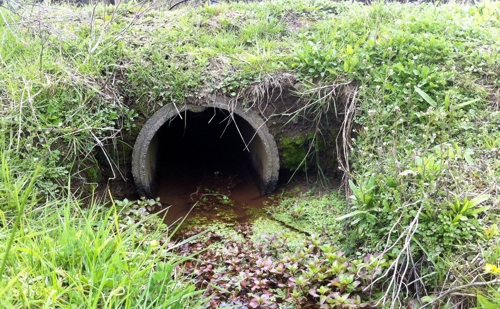Fish passage
New Zealand has more than 50 species of native freshwater and sports fish. It’s important that instream structures such as culverts and weirs are designed to allow for fish passage, so that fish can move upstream and downstream between different river and stream habitats and complete their lifecycle.
Culverts, weirs, flap gates, fords and dams installed after 3 September 2020 must meet minimum reporting requirements such as height, width and location under the Essential Freshwater regulations. Culverts, weirs and flap gates must meet minimum environmental conditions for fish passage and may need a resource consent.
While the new regulations do not apply to instream structures installed before 3 September 2020, it is still important to ensure those structures provide for fish passage. There are options for remediating or retrofitting structures to help fish passage.
The Fish-friendly culverts and rock ramps in small streams guidelines (PDF 608 KB) set out how to design instream structures that allow for fish passage.
Under national and regional rules, the installation, alteration, maintenance and removal of some structures is a permitted activity – and therefore does not require resource consent – only if you can meet the specific requirements outlined on this page.
Rules for fish passage
The National Environmental Standards for Freshwater 2020 (NES-F), introduced new national regulations for fish passage to be considered alongside regional rules in the Regional Plan.
These rules apply to all new instream structures , both temporary and permanent.
There are two main requirements under the NES-F:
- All new structures must be designed, installed and maintained in a way that will facilitate fish passage.
Specific design criteria for weirs and culverts must be followed. - You will need to provide information about the structure to us within 20 days of installation in accordance with NES-F Regulation 62.
Details on what information you will need to provide us depend on the type of structure and are outlined in the sections below.
For more information on how to collect and submit information to us, see "Reporting back to us".
Rules for culverts
The following national and regional rules apply if you are carrying out works to install or maintain a temporary or permanent culvert:
- Permitted activity conditions for culverts (NES-F Regulation 70). There are also requirements to provide information to the Northland regional Council (NES-F Regulation 62 and 63)
- Rule C.2.1.8 Construction and installation of structures – permitted activity (Regional Plan).
If you cannot meet all the requirements of both rules, you will have to apply for resource consent.
 A well-designed culvert allows fish to move through as part of their lifecycle, and reduces stream-bed scouring.
A well-designed culvert allows fish to move through as part of their lifecycle, and reduces stream-bed scouring.
Rules for weirs
The following national and regional rules apply if you are carrying out works to install or maintain a temporary or permanent weir:
- Permitted activity conditions for weirs (NES-F Regulation 72). There are also requirements to provide information to the Northland regional Council (NES-F Regulation 62 and 64).
- Rule C.3.1.2 Small dam – permitted activity (Regional Plan)
If you cannot meet all the requirements of both rules, you will have to apply for resource consent.
Rules for flap gates
A resource consent is always required for a passive flap gate (NES-F Regulation 74).
- flap gate means a hinged gate that controls fluctuations in tidal or flood water, such as a tide gate or flood gate
- a passive flap gate is flap gate which is not automated and whose opening or closing is caused by a positive head differential on the upstream or downstream side.
Rules for fords
The following national and regional rules apply if you are carrying out works to install or maintain a temporary or permanent ford:
- There are no NES-F rules for fords, but there requirements to provide information to the regional council (NES-F Regulation 62 and 67)
- Rule C.2.1.8 Construction and installation of structures – permitted activity (Regional Plan).
If you cannot meet the requirements of the rule you will have to apply for resource consent.
Rules for dams
The following national and regional rules apply if you are carrying out works to install or maintain a temporary or permanent dam:
- There are no NES-F rules for dams, but there requirements to provide information to the regional council (NES-F Regulation 62 and 66)
- Rule C.3.1.2 Small dam – permitted activity (Regional Plan).
If you cannot meet the requirements of the rule you will have to apply for resource consent.
Reporting back to us
When installing a structure in a waterway, you must provide information about the structure to us within 20 days of it being installed. Information must be provided for both permitted and consented activities.
Examples of the information commonly required include:
- The type of structure
- Physical characteristics of the structure
- Physical characteristics of the stream the structure has been installed within, such as the flow
- The likelihood of the structure to prevent fish passage
- Visual evidence both upstream and downstream of the structure.
See the links provided under the rules for each type of structure for the specific information requirements.
Need help?
We have expert staff to provide localised assistance and advice regarding land management, consents and compliance.
If you think you may require a resource consent, please contact us. We can arrange for you to have a free pre application meeting. For support in your local area, we can arrange for your local land management and biodiversity advisor to pop out for a chat, or to catch up with you online or via email to help sort things out.
More information
New Zealand Fish Passage Guidelines (at NIWA.co.nz)
Essential Freshwater: Fish passage factsheet | environment.govt.nz
